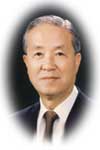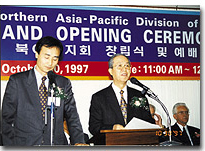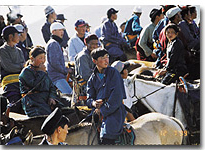Pyng Duk Chun, division president
 The Northern Asia-Pacific Division, together with its twin, the Southern Asia-Pacific Division, was born on January 1, 1997.
The Northern Asia-Pacific Division, together with its twin, the Southern Asia-Pacific Division, was born on January 1, 1997.
As the Adventist message progressed in Asia, a succession of divisions emerged. The Asiatic Division, organized in 1909, was the mother of the Far Eastern Division, the Southern Asia Division, the Australasian Division (which later became the South Pacific Division), and the China Division. The Far Eastern Division later became the Asia-Pacific Division, a distinction that lasted only two years.
 As it considered the great challenges and opportunities in the emerging Asia-Pacific region, the General Conference sought to strengthen evangelism in this territory by creating one more division. The Asia-Pacific Division was divided into the Northern Asia-Pacific Division and the Southern Asia-Pacific Division. At the same time, mainland China and Mongolia, former territories of the General Conference, became part of the Northern Asia-Pacific Division.
As it considered the great challenges and opportunities in the emerging Asia-Pacific region, the General Conference sought to strengthen evangelism in this territory by creating one more division. The Asia-Pacific Division was divided into the Northern Asia-Pacific Division and the Southern Asia-Pacific Division. At the same time, mainland China and Mongolia, former territories of the General Conference, became part of the Northern Asia-Pacific Division.
The two divisions decided to leave the beautiful and well-organized city-state of Singapore, where the Far Eastern/Asia-Pacific Division headquarters office had been located for more than 60 years, in order to decrease operating expenses. The Northern Asia-Pacific Division settled in Seoul, Korea, while the Southern Asia-Pacific Division developed a new headquarters near Manila, Philippines.

Kim Si Young, P.D. Chun, and L. R. Colburn (left to right) at the NSD opening ceremony, October 30, 1997. |
The Northern Asia-Pacific Division (NSD)is the largest world division in terms of population and the least penetrated with the gospel message. The greatest challenge, therefore, is Global Mission. In China alone there are more than 600 population segments of 1 million people where there is not a single Adventist member, and there are 465 cities of a half million people with no Adventists at all. A bold five-year project is under way to establish an Adventist presence in each of these 465 mega-cities through Global Mission pioneer workers.
Since China is a Communist nation, many restrictions are imposed on church activities, especially those with international involvement. Despite these restrictions, Adventist World Radio broadcasting has become a major means of evangelism and leadership training. One of the greatest needs of churches in China that can be met by outside assistance is church construction. In the past, Adventist congregations were not allowed to own their own church buildings; now it is permissible in many places to build churches funded from outside sources.
Publishing work plays a significant role in China as well in providing spiritual nurture and promoting unity among scattered Adventists. The Desire of Ages, Christ's Object Lessons, and Bible Readings for the Home have been translated and circulated with the full blessing of the authorities. Many other Ellen G. White books have been printed and circulated privately in China. Some 6,000 copies of the Adult Sabbath School Bible Study Guide are circulated every quarter, and the number of publications is steadily growing from year to year.
New Horizons in Mongolia

The Northern Asia-Pacific Division includes the Mongolian people. |
The country of Mongolia was an unentered territory when worldwide Global Mission was launched in 1990. Adventist Frontier Missions volunteers Brad and Cathie Jolly and Joan Park cultivated the soil of this long-forgotten country with the gospel message. Brother Jolly offered everything to the people, including his own life on the altar of Mongolian evangelism. That sacrifice was not in vain, as the team was able to witness the first baptism of eight souls in 1993.
The Adventist Church is now officially registered with the government. Membership has grown to 59.
Four congregations are currently meeting every Sabbath. An English Language School has recently been opened to reach educated young people. Pastor Dale Tunnell and his family arrived in 1998 in Ulaan Baatar, Mongolia, the first official Adventist missionaries in the land of Genghis Khan.
The Largest Union Mission
Have you ever imagined a union mission whose population exceeds more than one fifth of the world's population? That is the Chinese Union Mission, organized in 1999 by merging the former South China Island Union Mission and the former East Asia Association. The need for Global Mission in this territory is as great as its population.
The immense population is not the only challenge: the political environment also presents a formidable obstacle. Any form of outside influence or involvement is illegal. Any form of organization beyond the local congregation is not tolerated. Denominational distinction is opposed by government policy. Nevertheless, there are more than 2,600 local Sabbathkeeping congregations and 250,000 baptized members in mainland China.
1000 Missionary Movement-The Greatest Challenge of the Century
The 1000 Missionary Movement was launched in order to meet the two greatest challenges of our church-to proclaim the everlasting gospel to every nation, tribe, tongue, and people, and to keep our young people strong in the faith. There are numerous cities, towns, and villages in our division in which there is no Adventist presence, and planting an Adventist presence in these unentered territories presents a tremendous challenge.
Every year tens of thousands of young people are baptized. Sadly, though, we lose thousands of them each year as well. The NSD has discovered that the most effective means of retaining our young people is to train them for service to others.
A training center was established near Manila, Philippines, in 1992 to which young volunteer missionaries are recruited from far and near. After five weeks of intensive training they are dispatched to remote, unentered territories to establish new Adventist congregations. According to the report of Kim Si Young, the 1000 Missionary Movement director, the center has trained and sent out 1,426 volunteer missionaries to 26 countries of the world. These volunteers have come from 34 different countries, and as a result of their dedicated efforts, 17,048 persons have been baptized, 204 new congregations have been established, and 187 new chapels have been erected.
These wonderful results are still insignificant when compared with the tremendous impact upon each volunteer's personal spiritual life, and with the continued results that will be produced throughout their lifelong commitment in their home fields. The volunteers firmly believe that their commitment is not only for one year in the mission field, but rather to a lifelong dedication to the Lord and His work. Their motto is "Once a Missionary, Forever a Missionary." They will sustain the same spirit, dedication, and enthusiasm in their home mission field as they exhibited in foreign mission fields.
Perpetual Peace Through Gospel Power
Ruth Im, a Korean 1000 Missionary, and her Filipino partner were sent to an area where there is no Adventist presence-Talaingod Municipality, a remote mountain area in the southern part of Mindanao Island in the Philippines. When these two young missionaries arrived at the entrance of the community, armed guards stopped them. Although they explained their purpose in coming, the guards remained adamant and would not allow them to enter, saying, "No Christian has ever been allowed to enter this town." When the two young women persisted in their request to enter, the guards reported them to the municipality chief. Upon learning that they were Seventh-day Adventist missionaries, the chief gave orders to let them in and allowed them to freely go about their work. Because the chief had once attended an Adventist mission school many years ago, he felt kindly toward Adventists. These two young women were the first Christians to be allowed to enter that area, for which they gave God the praise.
It didn't take long for the missionaries to discover that the entire community consisted of Manobo and Ata tribes, so warlike that killing was part of their everyday experience. The tribes had been constantly fighting with and killing their neighboring village people for hundreds of years, even though the police and military forces had tried everything to stop the killing. Though the two missionaries were very frightened, they trusted in the Lord's protecting power and began their ministry to the women and children. They taught Christian songs and Bible stories, and also swept the streets, cleaned kitchens and toilets, and treated wounds. Gradually the people opened their hearts and accepted the gospel-first the children, then the women, and last, the men. Almost everyone in the village accepted Jesus Christ and was baptized.
But a new worry befell the people. If the neighboring tribe over the hill attacked them, they would not fight or kill the intruders because as Christians they could not kill people and would be in great danger of being killed or captured. The villagers entreated the two missionaries to go to the village over the hill and teach the same gospel. Accepting this challenge, the two young missionaries went to the next village and repeated the ministry. The result was the same. The whole village accepted the gospel and became Adventist Christians. But the same worry came to the minds of these villagers, and they asked the missionaries to evangelize the next neighboring village. This process was repeated from one village to another until all 11 villages in the Talaingod Municipality became Adventist villages.
Now 11 Adventist churches stand on the hilltops of Talaingod Municipality, and more than 1,700 baptized members flood the churches each Sabbath to praise and worship God. The fighting and killing have ceased. Former warriors carry Bibles instead of weapons. Peace, perpetual peace, prevails over the land. Songs of praise echo from mountain to mountain, from valley to valley.
All these changes took place within two years. Such conversions are the most powerful arguments for the transforming power of the gospel of Jesus Christ.
From English Learning to Gospel Learning

Language school Teachers in Taiwan. |
The demand to learn English is a worldwide phenomenon, but few capitalize on such a demand for gospel outreach. Japan and Taiwan have experienced a certain degree of success along these lines, but Korea has been tremendously successful. This year the Korean church celebrates its thirty-first anniversary of conducting an English Language School program. In spite of skepticism and criticism, the SDA English Language School program has been successful from its inception in winning many educated young people to the Lord. Every year 200-300 people become Adventists through SDA English Language Schools. More than 100 pastors, teachers, physicians, and nurses who had their first contact with Adventism through this program are serving in various capacities of denominational work.
In addition to English, there are Japanese, Chinese, and Spanish programs. About 30,000 young people come to 24 SDA English Language Schools five days a week. What a golden opportunity to witness to the students about the saving power of the gospel! Language Schools are not only self-sufficient, but also provide significant funds for general evangelistic outreach activities.




 FREE NEWSLETTER
FREE NEWSLETTER